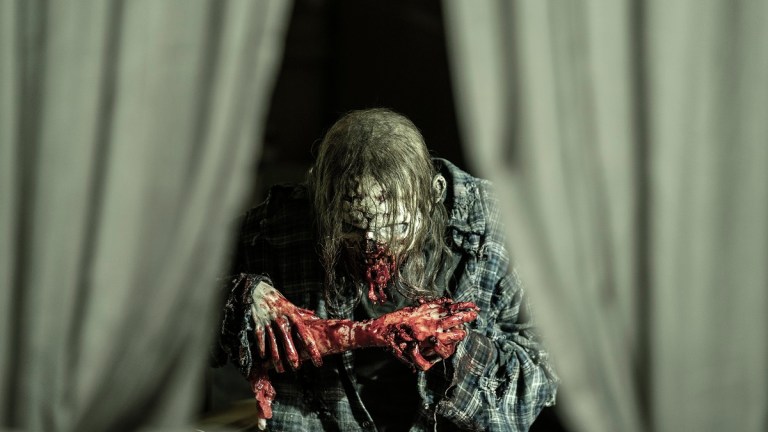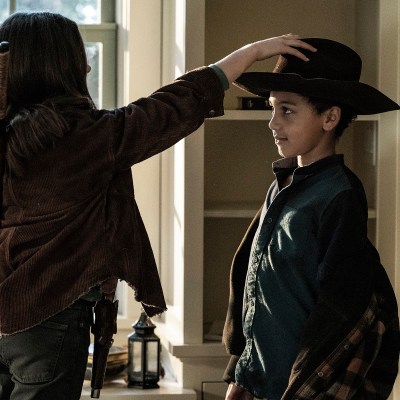The Walking Dead Season 11 Episode 24 Review: Rest In Peace
The Walking Dead finale brings the story to a close. But like any walker, it will rise again.

This The Walking Dead review contains spoilers.
The Walking Dead Season 11 Episode 24
At a certain point in a band’s career, there’s no point in making new albums except to have an excuse to tour. When the band is touring, the expectation is that the fans will politely sit through two or three new songs and bide their time until it’s time to play the hits. Not too long after that point, bands tour solely to play the hits. The Walking Dead is at that point, and they have an extensive catalog of hits to dip into to make sure that the series finale is a memorable one indeed. “Rest In Peace” might not have the energy or potency of a younger, hipper series, but there are a few surprises left in both the proverbial and literal gas tank.
In many ways, “Rest In Peace” is a look back at some of The Walking Dead‘s greatest hits. There’s a convoluted plan to blow something up to stop a horde of zombies. There’s a despot locking people out and leaving them to die to a horde. There’s a great series of set pieces in a hospital, serving as a reminder of one of the show’s most brutal deaths when Noah gets torn apart in front of Glenn. There’s a Grimes waking up out of a coma after being shot, like Rick and Carl both did. There’s even a character improbably escaping a zombie pile through sheer force of will and physical prowess, kind of like Tyreese did once upon a time.
However, the show references more than just itself. The Walking Dead digs deeply into the history of some of moviedom’s most well-known, well-loved moments. Walkers being incinerated by a fireball brings to mind Sarah Conner’s horrifying vision of World War 3 in Terminator 2. A walker using a brick to shatter a glass window is a direct pull from George A. Romero’s Night of the Living Dead. Even the needle drop chosen to drag the zombies into the trap set for them, the glorious rocker “Cult of Personality” by Living Colour, feels like a deliberate reference to the infamous Pipe Bomb/Gripe Bomb incidents of professional wrestler CM Punk. (Punk only blew up his career, once for good and once for ill, not a bunch of the undead, but it’s weird that he returns to the cultural zeitgeist after years away only for The Walking Dead to drop his theme music into the show.)
Those look-backs, that nostalgia, tracks with the way Season 11C has been laid out. There have been a lot of montages, reminders of the long history of The Walking Dead and the multitude of characters to have graced the screen since the show debuted on Halloween in 2010. There’s been a prolonged sense of nostalgia, of not forgetting the past as we built towards the future, of The Commonwealth repeating all of the mistakes of the old world rather than building something new and equitable, of remembering the journey now that it’s all about to be over.
Fitting, then, that directorial duties for the finale were handed over to Greg Nicotero, the special-effects wizard behind the show’s look and the show’s most frequent director. I would imagine long hours spent with actors in the makeup chair have helped Nicotero understand actors and how to best position them for success without losing his ability to craft some of the most stellar visuals in horror television history. Taking great bits from T2 and NotLD is one thing, but Nicotero crafts some of the best, most intricate set pieces on television.
Witness, for example, the scene in which Gabriel (Seth Gilliam), Eugene (Josh McDermitt), and Rosita (Christian Serratos) all attempt to escape from the orphanage with babies strapped to them. Eugene and Gabe get up the pipes easily enough, but Rosita is bringing up the rear, and she slips and falls into the mass, disappearing into their waiting arms. When she bursts out of the pile and starts laying waste, it’s beautifully done action from second unit director Tony Giglio that finishes with some impressively Romero touches. Rosita leaps from the top of an ambulance and grabs onto the pipe, and as she leaps over the horde, a wave of grasping hands follow her, all clawing at the air while she clambers up the pipe to safety.
Similar shots, particularly through the glass windows of the hospital as the dead press against them from the outside, also help to reinforce that sense of dread that waves of walkers in open space doesn’t quite capture. It’s live extras, and lots of them, that really reinforce that feeling of claustrophobia. The survivors are walled in, and the dead literally fill the streets by the hundreds, clustering at any open doorway with inhuman patience. All they’re looking for is an opportunity, and while the walls of The Commonwealth felt imprisoning, now they’re really stuck in a bad situation. High walls make a great prison, especially when the people in The Estates have taken all the guns, food, and supplies behind their strong iron gates. It’s a pretty efficient hammer and anvil situation that our old pals have to work their way out of. We know they will, because they’ve got help and lots of experience surviving terrible situations, it’s just a question of how, and who survives.
To their credit, the characters who haven’t gotten spin-off shows are all put in peril at several points, and there is a palpable feeling of risk, particularly after Rosita’s fall and a couple of early deaths. Unfortunately, that build-up never pays off in a real sense, though there are quite a few good scenes of various characters grieving over the few friends that are lost along the way. Josh McDermitt is an underrated part of this ensemble, and he’s the glue that holds a great deal of the latter half of the episode together, with Christian Serratos making the most of her scenes with both McDermitt and Seth Gilliam. The goodbye sequences for characters leaving at the end for their spin-offs are also well done, with Corey Reed and Jim Barnes’ script giving a lot of space for Melissa McBride and Norman Reedus to say goodbye to one another in the guise of their characters.
The story (credited to Angela Kang) is familiar enough, but it’s done very well, and a lot of emotion from off-screen finds its way on-screen. After 12 years of writing and thinking about this show and various spin-off properties, even I’m a little emotional at the thought of seeing it come to an end, and I haven’t spent years of my life sweating through my clothes in Georgia to make it happen. It’s never about the end, it’s always been about the journey. Maybe the real walking dead have been the friends we’ve made along the way?
That’s certainly what the show has been suggesting. The details of the spin-off shows are interesting enough, but the hook isn’t more zombies, the hook is more Daryl, Maggie, Negan, Michonne, and Rick. Good zombie media is out there (I highly recommend Black Summer), but it’s the promise of further adventures with characters we like that will bring fans back to the trough for The Walking Dead: Dead City, Daryl Dixon, and whatever they end up calling the untitled Richonne series. If you love something, it’s never truly gone.
The Walking Dead will never die.


